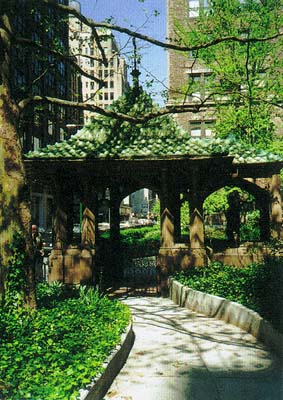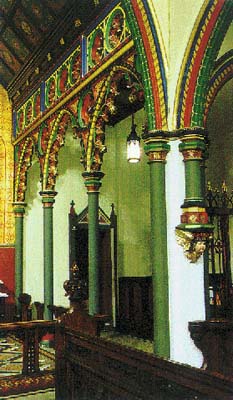 |
|

The church: The Church of the Transfiguration, New York City, USA.
Denomination: Episcopal Church in the USA.
The building: Cozy, Romanesque series of sacred alcoves. The exterior is delightful, because the church buildings are surrounded by a pleasant garden where anyone would long to curl up with a volume of theology. The interior is very tasteful, with exquisite stained glass (Victorian era, so slightly sentimental, but powerful in scriptural content), areas with attractive statues of Christ the King and of the Virgin and Child, and an elegant reredos with depictions of the Risen Christ. High Church without being Italianate, the building reminds one that the church's first vicar, a pioneer of the Oxford movement transplanted to the States, left a legacy of being Catholic while still English. The parish has had a close connection with the Episcopal Actors Guild since the Guild's foundation in 1923, and amongst the interior furnishing are monuments to such theatrical figures as Rex Harrison, Cornelia Otis Skinner, and P.G. Wodehouse.
The neighbourhood: In a style unique to New York City (where Fifth Avenue, the church's intersecting street, divides the East side from the West), one block separates the posh from the pits. The elegant buildings directly surrounding the church are a marked contrast to the very depressed neighbourhood which one would encounter on a walk west to Penn Station (as one unwise mystery worshipper was to find!).
The cast: The Rev Frederic Brunson, Jr., vicar, was the homilist. Other priests served as celebrant, deacon, and sub-deacon.
Solemn Eucharist and Sermon.
How full was the building?
About half full with an eclectic congregation – all ages, ethnic groups, styles of dress, and classes seemed to have a member or two in attendance.
Did anyone welcome you personally?
I received warm, enthusiastic greetings from the two ushers at the door, and engaged in a brief conversation. I had exchanged a wave and smile with one of the priests on my way through the garden to the church, and the pleasantly "Oxford movement lives" atmosphere was enhanced by seeing this tall, serious, cassock-clad gentleman taking a large dog for a walk through the foliage before Mass.
Was your pew comfortable?
Exceptionally so – padded seats, ample room for one's favoured prayer posture of curling up in the corner of the pew, and blessedly thick kneeling pads.
How would you describe the pre-service atmosphere?
Reverent, quiet, warm, with many smiles but few words exchanged.
What were the exact opening words of the service?
The Introit: "Mine eyes are looking unto the Lord for he shall pluck my feet out of the net." I found this quite apropos, considering both that my own eyes were exploring that gilt-surrounded reredos at the moment, and my feet, crying out in protest at a snug fit, had kicked off the Sunday shoes under the pew.
What books did the congregation use during the service?
1979 ECUSA Book of Common Prayer, Hymnal 1982, leaflet referencing the page numbers for prayers and hymns from either book. The eucharist was offered according to Rite 1 of the BCP (and, happily, was not mixed with other rites, as is not unusual with Anglo-Catholic parishes in the area).
What musical instruments were played?
Organ. The organist was quite accomplished, though I wish the congregation had not applauded after the postlude. The boy choir was fair to middling, and my (former musician's) heart went out to one chorister who performed a solo at offertory, of which the Titanic would have been a lesser disaster.
Did anything distract you?
Two young women and a baby, seated directly in front of me, swayed back and forth throughout most of the service. I could not decide whether they were rocking the baby or picking up leftover vibes from some 1970s charismatic wind.
Was the worship stiff-upper-lip, happy clappy, or what?
I had the feeling that the Oxford movement had been moved to the year 2000, the only missing link being the absence of "down with popery" crowds outdoors and the tank shirts some in attendance were wearing. In a fashion for which it is difficult to give specific examples, there was a flavour of both the Catholic fervour and rather homely attributes of the Oxford movement crowd.

Exactly how long was the sermon?
14 minutes.
On a scale of 1-10, how good was the preacher?
7. Father Brunson's excellent points were very thought provoking, and his incorporating how the Christian calling expressed in the Gospel needs to be alive today was a fine challenge. His delivery, unfortunately, was the "read from a paper" style that lacks both dynamic and contemplative impact.
In a nutshell, what was the sermon
about?
This is an "age of categories", where we try to reduce all to simple black and white concepts. We judge others by our actions, ourselves by our ideals. This can lead to over-simplifying rather than to truth, much as the Pharisees' vision was blocked by pre-conceived ideas to a point where they could not recognise the Messiah.
Which part of the service was like being in
heaven?
The litany, conducted in procession, even if the intonation did not bring choirs of angels to mind, had a quality of humble petition that made me believe we just might get all that we were asking God for. I also found the sermon quite inspiring. I would imagine, in the Anglo-Catholic section of heaven, that things are this homely and comfortable on dress-down days.
And which part was like being in... er... the other place?
Nothing – I saw no glimpses of Hell until I turned the corner and confronted the nitty gritty of Broadway rather than the elegance of Fifth Avenue.
What happened when you hung around after the service looking lost?
The crowd was too friendly for anyone to be lost. I ended up in an animated conversation with a university student.
How would you describe the after-service
coffee?
No chance to sample it – I needed to catch the 1.00pm bus.
How would you feel about making this church your regular (where 10 = ecstatic, 0 = terminal)?
8.
Did the service make you feel glad to be a
Christian?
Happily Christian, Catholic, and Anglican... in fact, pining though I am for London, it very nearly made me happy to be in New York.
What one thing will you remember about all this in seven days' time?
"Judging others by their actions, ourselves by high ideals."
| The Mystery Worshipper is sponsored by surefish.co.uk, the internet service provider from Christian Aid. By offering email services, special offers with companies such as amazon.co.uk and smile.co.uk, surefish raises more than £300,000 a year for Christian Aid's work around the world. Click here to find out how to become a Mystery Worshipper. And click here if you would like to reproduce this report in your church magazine or website. Top | Other Reports | Become a Mystery Worshipper! © Ship of Fools 2000 |